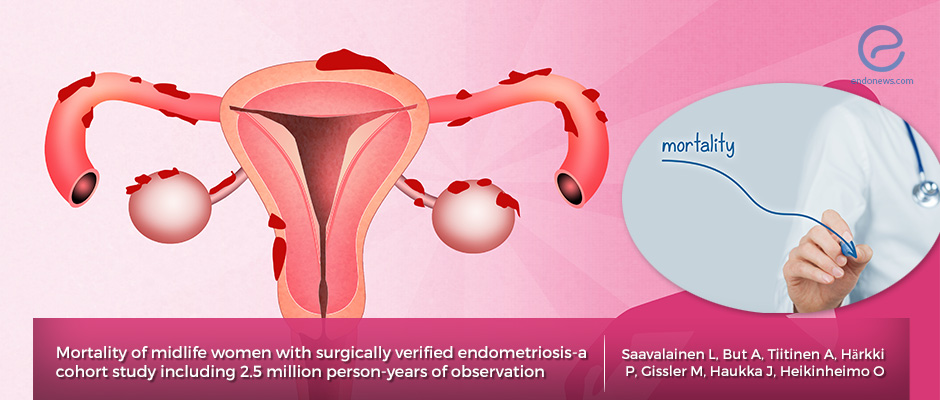Mortality of 49956 midlife women with surgically verified endometriosis
Aug 5, 2019
Lower Mortality in midlife women with surgically verified endometriosis.
Key Points
Highlights:
- The mortality due to cancer, circulatory diseases, cardiovascular diseases, alcohol-related causes, accidents and violence, and diseases of the digestive and respiratory systems were all decreased in the endometriosis cohort.
Importance:
- Valuable data was provided to women with endometriosis and to their health care providers.
What’s done here?
- The authors conducted a nationwide retrospective cohort study of women with a surgically verified diagnosis of endometriosis comparing to the reference cohort in Finland between 1987–2012. The median follow-up was17 years and 2.5 million person-years accumulated.
Key Points:
- Endometriosis and reference cohorts consisted of 49956 and 98824 patients, respectively; the number of deaths seen was 1656 and 4291, respectively.
- Deaths in the endometriosis cohort, 49% were due to malignant neoplasms, 17% due to diseases of the circulatory system, and 12% due to accidents and violence.
- Lower all-cause mortality was seen for the endometriosis cohort; there were four deaths less per 1000 women over 10 years.
Limitations:
- These risk factors (smoking, alcohol consumption, BMI, or use of medications) that contribute to the development and prognosis of several illnesses and, to deaths could not be adjusted for as they do not exist in the register-based data of the researchers.
- These results are limited to women with endometriosis diagnosed by surgery.
- The study does not extend into the oldest age groups.
Lay Summary
Saavalainen L. et al., from Finland recently published a retrospective large cohort study in the journal Human Reproduction, where they retrospectively examined the data of surgically verified endometriosis patients to find out if all-cause and the cause-specific mortality rate is increased in endometriosis patients.
All endometriosis-associated diagnoses 1987 to 2012 were identified from the Finnish Hospital Discharge Register to identify surgically diagnosed cases. Altogether 57713 endometriosis diagnoses were detected among 49956 women. The reference cohort (n =98824) was randomly drawn by a computer from the Finnish Population Information System. The reference cohort included two women for each endometriosis patient who was alive, lived in the same municipality and were of similar age on the index date and had no surgically verified endometriosis. Follow-up ended at death or 31 December 2014. During the median follow-up of 17 years, 2.5 million person-years accumulated.
The age of the endometriosis cohort was 36.4 ± 9.0 and 53.6 ± 12.1 years in the beginning and at the end of the follow-up, respectively. The most common diagnosis in the endometriosis cohort was found to be peritoneal endometriosis (46%) followed by ovarian endometriosis (42%), other or unknown endometriosis (6%), and deep infiltrating endometriosis (6%). The researchers observed that deaths in the endometriosis cohort, 49% were due to malignant neoplasms, 17% due to diseases of the circulatory system, and 12% due to accidents and violence. Compared to the reference cohort (25.9 per 1000 women over 10 years), the all-cause mortality rate was detected to be decreased in the endometriosis cohort (19.6 per 1000 women over 10 years).
There are three main strengths of the present study. First, the authors studied patients with surgically diagnosed endometriosis. Second, the large, population-based cohort of women was examined. Third, the follow-up of the patients was long (nearly three decades of calendar time and a follow-up of 2.5 million person-years). However, the current study may also be subject to selection bias, bias by indication, detection bias, or reverse causality.
According to the authors, more studies on this issue is needed since the decreased mortality is significantly due to different characteristics and factors related to women’s lifestyle and/or increased medical attention and care received among women with surgically verified endometriosis.
Research Source: https://www.ncbi.nlm.nih.gov/pubmed/31265075
mortality endometriosis cause-of-death cardiovascular mortality cancer mortality

